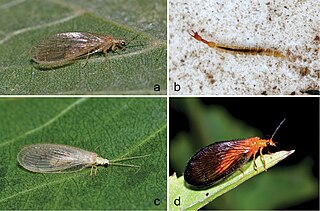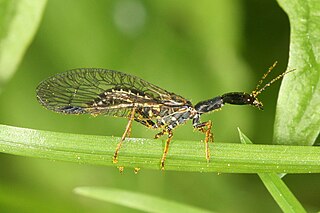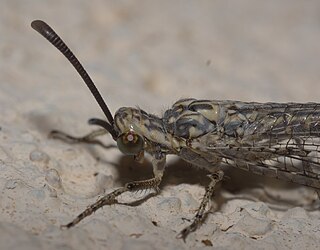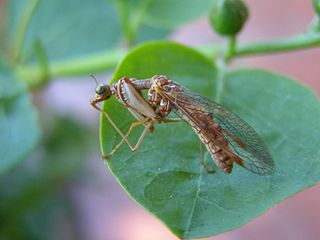
Mantispidae, known commonly as mantidflies, mantispids, mantid lacewings, mantisflies or mantis-flies, is a family of small to moderate-sized insects in the order Neuroptera. There are many genera with around 400 species worldwide, especially in the tropics and subtropics. Only 5 species of Mantispa occur in Europe. As their names suggest, members of the group possess raptorial forelimbs similar to those of praying mantis, a case of convergent evolution.

The Berothidae are a family of winged insects of the order Neuroptera. They are known commonly as the beaded lacewings. The family was first named by Anton Handlirsch in 1906.

The Nevrorthidae, often incorrectly spelled "Neurorthidae", are a small family of winged insects of the order Neuroptera. Extant species may be described as living fossils. There are 19 extant species in four genera, with a geographically disjunct distribution, Nevrorthus, comprising 5 species with scattered distributions around the Mediterranean, Austroneurorthus with two species known from southeastern Australia, Nipponeurorthus comprising 11 species known from China and Japan, and Sinoneurorthus known from a single species described from Yunnan Province, China. They were at one time placed in the Osmyloidea, with the Osmylidae and the spongillaflies (Sisyridae) as their closest relatives, but nowadays they are considered to be the most ancient lineage of living lacewings. Sometimes they are placed in a suborder Nevrorthiformia, but the quite basal position of the family is probably better expressed by placing them directly in the Neuroptera, without assigning the subordinal rank.

The dustywings, Coniopterygidae, are a family of Pterygota of the net-winged insect order (Neuroptera). About 460 living species are known. These tiny insects can usually be determined to genus with a hand lens according to their wing venation, but to distinguish species, examination of the genitals by microscope is usually necessary.

Alderflies are megalopteran insects of the family Sialidae. They are closely related to the dobsonflies and fishflies as well as to the prehistoric Euchauliodidae. All living alderflies – about 66 species all together – are part of the subfamily Sialinae, which contains between one and seven extant genera according to different scientists' views.

Inocelliidae is a small family of snakeflies containing 8 genera of which one is known only from fossils. They are commonly known as inocelliid snakeflies. The largest known species is Fibla carpenteri known from fossils found in baltic amber.

Phaeostigma is a Palaearctic genus of snakeflies in the family Raphidiidae.
Florissantoraphidia is an extinct genus of snakefly in the family Raphidiidae containing two described species Florissantoraphidia funerata and Florissantoraphidia mortua. Both species were originally described in the living raphidiid]] genus Raphidia, as Raphidia funerata and Raphidia mortua respectively. before being redescribed and transferred to the newly erected genus.

Raphidiidae is a family of snakeflies in the order Raphidioptera.

Raphidia is a genus of snakefly, mainly found in Europe.

Negha is a genus of square-headed snakeflies in the family Inocelliidae. There are at least three described species in Negha.

Scotoleon is a genus of antlions in the family Myrmeleontidae. There are more than 20 described species in Scotoleon.

Megalomus hirtus, common name bordered brown lacewing, is a species of brown lacewings in the family Hemerobiidae.

Dichrostigma is a genus of snakeflies in the family Raphidiidae. There are about five described species in the genus.

Mantispa is the type genus of insects in the family Mantispidae and subfamily Mantispinae. Species have a fairly worldwide distribution.

Xanthostigma is a genus of snakeflies belonging to the family Raphidiidae.
Nemia is a genus of insects belonging to the family Nemopteridae.
Ameromyia is a genus of antlions belonging to the family Myrmeleontidae.
Banyutus is a genus of antlions belonging to the family Myrmeleontidae.

Inocellia is the Palaearctic type genus of the family Inocelliidae: belonging to the snakeflies and their allies. Distribution records are from mainland Europe and Asia: especially in the more temperate zones.
















